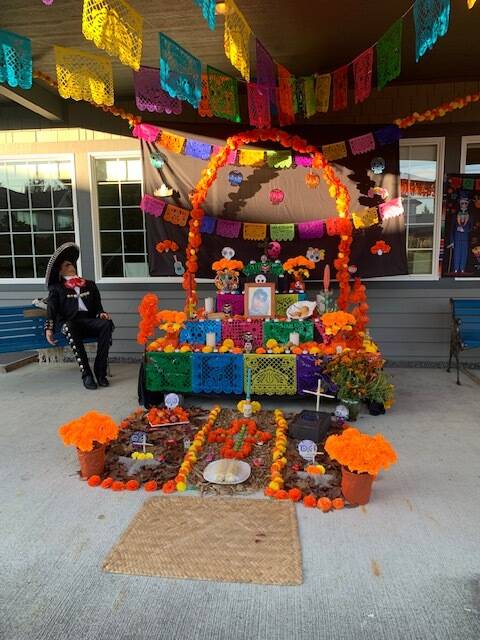Skull-shaped cookies and candy, orange flowers and candles are a few images that come to mind when Day of the Dead is mentioned. For the first time, the Joyce Sobel Family Resource Center hosted a traditional Dia de los Muertos celebration on Nov. 1 and 2.
“A new generation of Latinos are being born on the island, and have not had a chance to visit their homeland or at least visit during this time,” said co-organizer Adriana Gonzalez. “We wanted to show them the traditions.”
Dia de los Muertos is one of the most important celebrations, both Gonzalez and fellow coordinator Carmen Orozco said.
Often Dia de los Muertos is equated with Halloween, but the two are very different. Orozco explained that after someone dies, this is a chance when they can visit.
“It’s a time when we meet all together again. We can’t see them, but we can feel them,” Gonzales said.
Sometimes, for example, in Janitzio, a Mexican island, people adorn the cemetery with flowers and spend the whole night with their deceased loved ones.
According to a press release by the family resource center, in pre-Hispanic times, death was considered a basic element of culture to be acknowledged and celebrated. When a loved one died, they were buried wrapped in a petate (handmade rug) and relatives organized a party in order to guide them on their journey to Mictlán, a place where souls can rest.
During Dia de los Muertos, death does not represent an absence but a living presence. The spirits of all deceased children (Angelitos) are allowed to reunite with their families on Nov. 1 and on Nov. 2, the spirits of the adults come down to enjoy the festivities that are prepared for them.
Warm drinks and sweets were offered at the event, and signs explained aspects of the tradition.
Mantel blanco y sal (white tablecloth and salt) means purity and joy. The salt serves so that the body of the deceased does not become corrupt on their trip.
Agua (water) to quench their thirst on the journey towards the world of the living. It is also an element of purity, so the spirits may wash.
Velas y veladoras (flames and candles) represent faith and hope. They act as a guide for the dead to find their way back home.
Copal y cruz de cenizas (copal and cross of ashes) are to cleanse the bad vibes and evil spirits before the loved ones arrive.
“It is incense,” Orozco explained. “It gets rid of any bad vibes and it smells really good.”
Flores (flowers) are a festive symbol due to their colors and aroma that adorn the area souls will be. Marigolds are used most commonly as their color represents the sun, which guides the soul of the deceased.
Comida, bebida, y Pan de Muerto (food, beverages and Bread of the Dead) to delight the dead who visit the offering. Favorite foods and beverages are provided to the souls to honor and remember them.
Retrato (photographs) of loved ones means they will visit the offering.
And last but most importantly, El Arco, or the arch. The arch represents the gateway of the dead to the living which is why it is so important and placed at the last level of the altar. It is characterized by being decorated with Marigolds.
On Nov. 1, activities for children were set up, and food, bottles of soda, hot cocoa, water, toys and candles were left for the Angelitos. The following day, Nov. 2, cigarettes and shots of mezcal or tequila were offered to the adults. The lawn outside the Mullis Center was full of families. Children had their faces painted while adults took in the festivities and chatted. Dancing also plays a large part in the festivities, according to Orozco. At 5 p.m., on Nov. 2, dancers donned masks, hats and sandals to perform some traditional dances. One of the dancers was a young child. Their talent and footwork awed the attendees. As the dancers stopped, the crowd called “mas! (more!)” They complied, and for the final dance, a few participants joined with dancers to form a chain and danced their way through and around those who remained watching.
“We hope this will only grow, and we will have women dancers as well,” Gonzalez told attendees as the dancers finished.
“It’s important to remind people of our heritage,” Orozco told the Journal later. “A lot of Latinos have made this place their home.”




